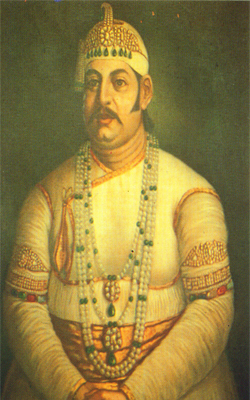
|
|
|
Mir Tahniath Au Khan Afzal—ud--Daula was born on 11th October, 1827. He was the eldest son of Nawab Nasir-ud-Daula. He ascended the throne on 18th May, 1857 and Indian Mutiny (First war of Independence) was started on 17th July, 1857. Rohilas attacked the Residency but Sir Salar Jung put down the attack with a firm hand. Similar trouble was started in Sholapur but the Maharaja of Sholapur was unable to control the situation. Hence the Sholapur territory and the Raichur district were transferred to the Nizam by the English yielding a revenue of Rs. 21 lakh per annum but Berar was retained in trust by the British for the purpose specified in the treaty of 1853. During the Mutiny the Governor of Bombay Presidency had telegraphed to the British Resident at Hyderabad “If the Nizam goes, all goes”.
On 27th January, 1858 Sir John Lawrence, the Chief Commissioner of Punjab, ordered an enquiry against Bahadur Shah Zafar and with the help of false witnesses exiled him to Rangoon. At that time, the name of Bahadur Shah was on all the coins which were in circulation in Hyderabad. The British sent a message to Nawab Afzal-ud-Daula to remove the name of Bahadur Shah from the coins. Afzal-ud-Daula refused to do so saying, “How can I remove the name of Bahadur Shah from the coins when he is still alive”. However, after much persuasion by his uncle Amir-e-Kabir, Shams-ul-Umara, the name of Bahadur Shah was removed from the coins and was replaced by the wording “Nizam-ul-MuLk Asaf Jab Bahadur” on one side and “Julus Maimanut Zarb Farkhunda Bunyad, Hyderabad” (Minted at Hyderabad) and “Julus Maimanut” (Lucky Regional Year) on the other. Therefrom the coins of the Mughal Emperor ceased to be current in Hyderabad. These coins were named as “Hali Sicca”.
Subsequently the name of Bahadur Shah was discontinued from the Friday prayers “Qutba” and replaced by the name of Nawab Afzal-udD aula. 1857 was an important year as the Mughal dynasty vanished and the Nizam ceased to be a Mughal Subedar.
After the Mutiny, Queen Victoria wanted to confer the title of G.C.S.I. but Afzul-ud-Daula refused to accept it suspecting a political motive in the offer. But the Resident assured him that there was no political motive behind the offer, and so Nawab Afzal-ud-Daula accepted the title. On 31st August, 1861 the order of the Star of India was conferred on Nawab Afzal-ud-Daula.
In 1866 there was some misunderstanding between Afzal- ud—Daula and Sir Salar Jung. Consequently Nawab Sir Salar Jung resigned as the Prime Minister. At that time Sir George Yule was the Resident. He informed Nawab Afzal-ud-Daula that Sir Salar Jung was a very able administrator and without him the State would suffer. Hence Sir Salar Jung was again made Prime Minister of the Dominion.
During the time of Nawab Afzal-ud-Daula the Dominion was divided into five Subas and sixteen districts.
Each Suba was headed by a Subedar and each district was under a Taluqdar. The reign of Nawab Afzal-ud Daula was very eventful as several districts were returned to the Dominion by the British and the State was free from any revolt, particularly after the Indian Mutiny.
In 1860, the Nizam gave the land required by the Bombay-Madras railway line passing through Hyderabad State in the Raichur Doab. The railway line was later extended upto Wadi. A new line called Nizam State Railway was introduced to connect Hyderabad. The introduction of a railway linking Hyderabad contributed much to the economic development of the State.
During the reign of Nawab Afzal-ud-Daula, the reforms carried out by Sir Salar Jung included the establishment of a Government central treasury in 1855, establishment of stamp paper office in 1856, and grant of liberal loans to the peasants to improve their economic condition.
Afzal-ud-Daula was a very religious man and he ordered the removal of all liquor shops from within the city limits. He was also responsible for the construction of Afzal Gunj Mosque, Afzal Gunj Bridge and the Afzal Gunj Bazar.
Afzal-ud-Daula died at the young age of 42 years on Friday, 26th February 1869, after reigning for 12 years. He was buried in the Mecca Masjid Royal cemetery. At the time of his death his heir-apparent and only son, Nawab Mir Mahboob Ali Khan, was about three years old.
|
|